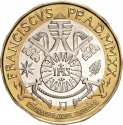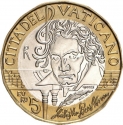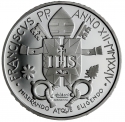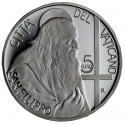You are about to finish your registration. Please check your mailbox (including spam folder). There should be a letter with a confirmation link. Check setting to make sure that your e-mail address is correct.
Send letter againDescription
Francis Petrarch (1304–1374), born Francesco di Petracco, was an early Italian Renaissance scholar and poet, and one of the first humanists.
Petrarch's rediscovery of Cicero's letters is credited with starting the 14th-century Italian Renaissance and founding Renaissance humanism. In the 16th century, Pietro Bembo used Petrarch's works, along with those of Boccaccio and Dante, to create the modern Italian language model. The Accademia della Crusca later endorsed Petrarch as a model for Italian style.
Petrarch's sonnets were widely admired and imitated in Europe during the Renaissance, setting the standard for lyrical poetry. He is also known for coining the term "Dark Ages."
Engraver: Valerio De Seta
Designer: Gabriele Di Maulo
Obverse

|
Depicts Pope Francis's crowned coat of arms encircled by the inscription "Pope Francis Year 12 2024" above and "By having mercy and by choosing" below. The engraver's and designer's names are in the middle and the right. • FRANCISCVS PONT. MAX.• |
|---|---|
Reverse

|
Depicts Francis Petrarch presenting a laurel branch to Laura, whose angelic form appears with her hair flowing like an aura in a light breeze. The state name "Vatican City" is above, the denomination is in the center, the mintmark of the Italian State Mint and Polygraphic Institute (R) is on the left, and the poet's name, the death and the coin issue years are on the right. CITTA´ del VATICANO |
| Edge |
5 Euro
650th Anniversary of Death of Francis Petrarch
KM#
650th Anniversary of Death of Francis Petrarch
Characteristics
| Type | Commemorative Issue (Non-circulating) |
| Material | Bi-Metallic |
| Ring | Bronzital |
| Center | Cupronickel |
| Weight | 9.5 g |
| Diameter | 27.5 mm |
| Thickness | - |
| Shape |
|
| Sides | 16 |
| Alignment | Medal |
| Mint |
Italian State Mint and Polygraphic Institute (IPZS)
|
Related coins
250th Anniversary of Birth of Ludwig van Beethoven





